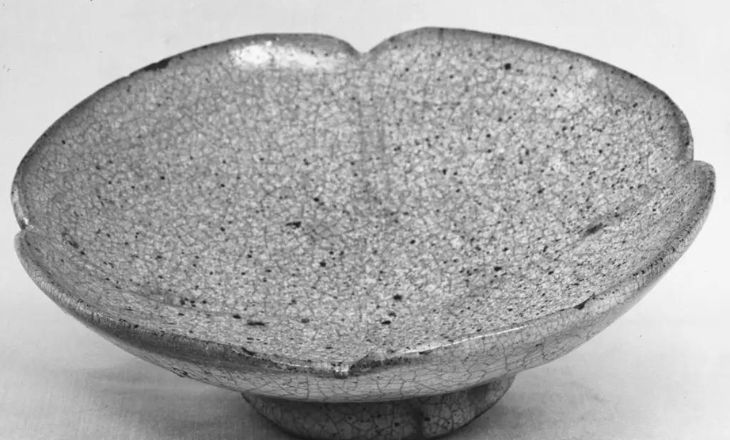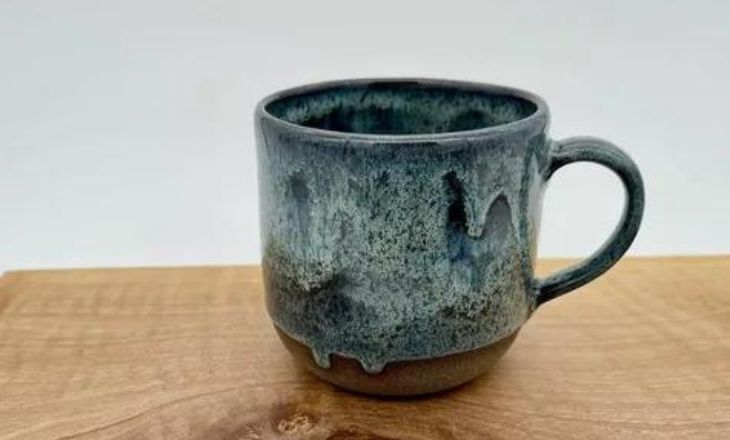Crazing is also sometimes referred to as crackle. While it can have a decorative appeal, it’s not ideal for functional pottery.
In this conversation, we’ll delve into the world of crazing, exploring what causes it and how to prevent it in your pottery creations. We’ll discuss:
- The science behind crazing: Why these tiny cracks appear
- Why crazing might be a concern, especially for functional pieces
- Techniques to avoid crazing in your pottery
What is Crazing?
Crazing Ceramics /Crazing glazes refers to a network of fine cracks that appear on the glazed surface of fired pottery. These cracks are typically hairline thin and may form a web-like pattern across the glaze.
It might look like the pottery itself is cracked, but crazing is a surface-level phenomenon cracks reside within the glaze layer, not penetrating the entire body of the clay.
What are the Key Causes of Crazing?
There are two main culprits behind crazing pottery in various materials:
Thermal Expansion Mismatch:
This is the most common cause, especially in ceramics like pottery and concrete. Clay and glaze (or concrete and its paste) expand at different rates during firing or drying, and when they cool down, this mismatch creates tension.
If the glaze (or paste) shrinks more than the body, it pulls on the surface and cracks appear as crazing.
Moisture and Environmental Factors:
Rapid changes in temperature and humidity can also contribute to crazing. For example, with concrete, fluctuations in these factors can cause a surface layer rich in cement to experience more stress and become susceptible to crazing.
For glazed pottery, moisture getting into the glaze or repeated physical stress can also lead to crazing.
How can you avoid crazing and what can you do to fix it?
There’s no magic bullet to fix existing crazing on a fired piece. The cracks themselves are permanent. You can prevent crazing in future pottery creations. Here are some techniques to achieve a good glaze-clay body fit and avoid crazing:
Adjusting Glaze Composition:
- Increase Silica:
Silica has a low thermal expansion coefficient, meaning it expands less with heat. Adding more silica to your glaze can help it match the clay body’s expansion rate.
- Reduce Feldspar:
Feldspar, a common glaze ingredient, has a high expansion coefficient. Reducing its amount can help minimize crazing.
- Use Low-Expansion Fluxes:
Materials like talc or magnesium oxide have low expansion and can be incorporated into the glaze to improve the fit.
- Adjusting Clay Body:
While glaze modification is common, you can also consider it.
- Adding Silica to Clay Body:
Similar to the glaze, adding silica to the clay itself can bring its expansion rate closer to the glaze.
Firing Techniques:
- Fire to the Correct Temperature:
Ensure you’re firing your pottery to the recommended cone for your chosen clay and glaze combination.
- Slower Cooling:
A slow and controlled cool-down period after firing allows the glaze and clay to contract at similar rates, reducing stress and crazing.
- Glaze Application:
Applying a thinner glaze coat creates less tension and reduces the chance of crazing. The safety of using dishes with crazing depends on several factors:
Are Dishes With Crazing Safe to Use?
Light crazing with fine lines may pose less risk than extensive crazing with deeper cracks. Using crazed dishes for dry foods like cookies is generally considered lower risk than using them for liquids or acidic foods.
Liquids and acidic foods can seep into the cracks, potentially harboring bacteria and leaching lead or other metals (if present) from older glazes. Modern, well-made glazes fired at high temperatures are typically safe for use even with some crazing.

Older glazes, especially those containing lead, could pose a higher health risk if crazing allows them to leach into food.
Here’s a breakdown of the potential risks and considerations:
Bacteria Growth:
Crazing creates tiny crevices where bacteria can potentially hide and grow, especially if not cleaned properly. For dishes with significant crazing, thorough cleaning and sanitizing are essential.
Leachable Metals:
Lead was a common glaze ingredient in the past. If your crazed dishes are older and you’re unsure about the glaze composition, it’s best to avoid using them for food altogether. You can get your dishes tested for lead content if concerned.
Functional Woes: Why Crazing Matters
Some might find the crackled appearance of crazing visually interesting, it can wreak havoc on the functionality of your pottery. Here’s why crazing is a concern for potters who create pieces meant for everyday use:
Compromised Strength:
Imagine a delicate spiderweb etched across the surface of your favorite mug. Crazing weakens the overall structure of the pottery. The tiny cracks act like stress points, making the piece more susceptible to breaking or chipping, especially with everyday wear and tear.
Leakage Woes:
Crazing creates a network of pathways throughout the glaze. These cracks, although seemingly small, can allow liquids to seep through, potentially reaching the clay body beneath. This can be problematic for several reasons:
- Food Safety:
If liquids can penetrate the glaze, so can bacteria. Crazed pottery can become a breeding ground for bacteria, especially if not cleaned thoroughly after each use.
- Loss of Functionality:
For dishes meant to hold liquids, crazing defeats the purpose. Soupy concoctions or refreshing beverages can leak through the cracks, rendering the pottery unusable for its intended function.
Aesthetic Deterioration:
Over time, crazing can worsen. Food particles and liquids can become trapped within the cracks, leading to discoloration and a less appealing appearance. This detracts from the overall aesthetics of the piece.
The Art of Experimentation: Glaze Testing for Optimal Results
Conquering crazing in pottery can feel like a battle against the elements – a delicate balance between the clay body and the glaze. But fear not, fellow potter! There’s a powerful weapon in your arsenal: glaze testing.
Glaze testing is an essential practice for any potter who wants to create predictable and successful glazes. It allows you to experiment with different glaze compositions and see how they interact with your chosen clay body.

In the fight against crazing, glaze testing becomes your training ground. Here’s how glaze testing empowers you to achieve a perfect glaze-clay body fit and prevent crazing:
- Understanding Your Glaze: Through testing, you gain a deeper understanding of how your base glaze recipe behaves. You can observe its melting point, glossiness, and overall character.
- Making Informed Adjustments: Glaze testing allows you to put these adjustments into practice. By testing glazes with these modifications, you can see how they impact the glaze’s characteristics and, more importantly, how they influence crazing.
- Finding the Perfect Balance: Glaze testing isn’t about achieving a single ideal outcome. It’s about exploration and iteration. Through testing different glaze variations, you can find the perfect balance between achieving the desired aesthetics and preventing crazing.
Tips for Glaze Testing:
- Start Small: Don’t overwhelm yourself with drastic changes. Begin by making small incremental adjustments to your base glaze recipe and test the results.
- Document Everything: Keep meticulous records of your glaze modifications and the results of your tests. This will help you track your progress and identify trends.
- Test on Multiple Surfaces: Don’t rely on testing only on flat tiles. Test your glazes on curved forms as well, as curvature can influence how the glaze interacts with the clay body.
Glaze testing might seem like an extra step, but it’s an investment in your pottery journey. By embracing experimentation and learning from your tests, you can develop glazes that are not only beautiful but also free from the woes of crazing.
Glass Crazing:
Crazing, those fine cracks on a surface, can also happen to glass for reasons beyond ceramics. In glass, crazing results from uneven stress caused by thermal shock (rapid temperature changes) or physical impact.
Manufacturing defects like air bubbles can also be culprits. While it affects the entire glass unlike ceramic glaze, minor crazing might not be a big deal. Extensive crazing weakens the glass and makes it more likely to shatter.
To prevent this, manufacturers use annealing (slow cooling) or tempering (special heat treatment) to relieve stress in the glass.
Conclusion
We have to discuss in the above lines about cracking so we concluded that the network of fine cracks marring a seemingly perfect glazed surface can be a source of frustration for potters. By understanding the science behind crazing and the factors that contribute to it, you’ve gained valuable knowledge to conquer this glaze foe.
This journey has explored the reasons why crazing occurs, its impact on the functionality and aesthetics of your pottery, and most importantly, the strategies to prevent it. We’ve delved into modifying glaze composition, exploring firing techniques, and the crucial role of glaze testing.
Creating beautiful and functional pottery is an art form, and preventing crazing is a skill to be honed. Embrace experimentation, utilize glaze testing as your training ground, and don’t be afraid to consult fellow potters and resources.
FAQS
What Is Crazed Cracking?
Craze cracks on concrete are when the surface of concrete develops a lot of fine cracks.
What is the Process of Crazing?
When an amorphous brittle polymer is loaded in tension, a phenomenon known as crazing can occur. Crazing involves the formation of small crack-shaped regions that are drawn down but remain constrained by the surrounding material.
